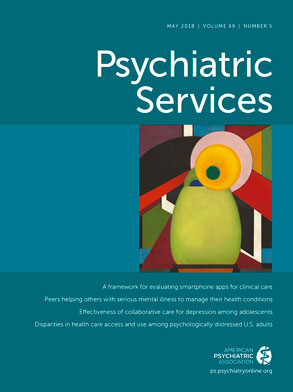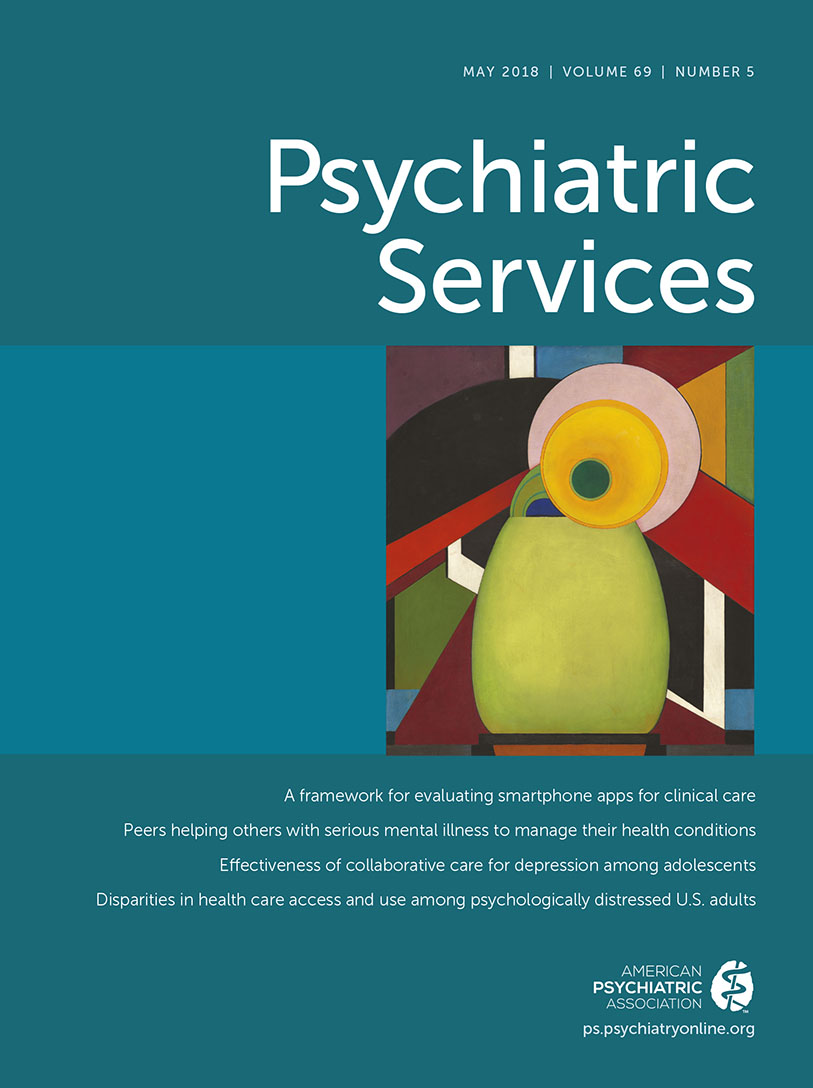Approximately 17% or more of college students have a mental health problem (
1). However, nearly two-thirds of students with mental health problems do not use mental health services, even when on-campus services are available (
2,
3). If untreated, mental health problems can persist and lead to long-term consequences, including lower academic achievement and unemployment or underemployment (
4,
5). Alternative solutions to addressing mental health problems among college students are needed. Such alternatives are particularly important for community college students, who have higher rates of unmet treatment need than peers in traditional four-year institutions (
3,
6) and who may face unique barriers to accessing services (for example, a lower likelihood of services on community college campuses and poor access to on-campus services when they are available because of part-time or commuter status) (
3,
7).
Online mental health services (also known as telepsychology, e–mental health, and online therapy) are alternative platforms that allow treatment to be delivered remotely through a computer or mobile device (
8) and that may facilitate increased access to and use of treatments for a range of psychological problems and patient populations (
8,
9). Preliminary evidence suggests that these services can effectively treat some conditions (for example, eating disorders, depression, and anxiety) (
8,
9). College students report favorable attitudes toward online mental health services (
10–
13), which may be more appealing to students with psychological distress (
11). However, little is known about attitudes toward online mental health services among community college students with mental health treatment need.
To address this gap in the literature, we examined attitudes toward online mental health services in a large, diverse sample of community college students, focusing on students with mental health treatment need. Understanding attitudes toward online services has significant implications for the feasibility of these services to address unmet mental health treatment need, particularly in student populations that may be difficult to reach through conventional in-person counseling.
Methods
Community college students completed an online survey during the 2017 spring semester as part of the evaluation of the California Mental Health Services Authority Student Mental Health Initiative (
14). Fifteen California Community College campuses were invited to participate, and eight agreed. Campus representatives distributed campuswide e-mail invitations to a convenience sample of 101,550 students. A total of 6,034 students (6%) completed the survey, and 1,557 met study criteria for mental health treatment need. The RAND Institutional Review Board approved the study.
Serious psychological distress was assessed by the K6, a reliable, valid six-item measure assessing the frequency of symptoms such as hopelessness and worthlessness in the past 30 days (
15). Mental health treatment need was defined as having a K6 score ≥13 (possible scores range from 0 to 24).
Students reported (yes or no) whether they had ever used in-person services (on or off campus or both) while attending their current college campus and whether they had ever used online services. Prior in-person treatment was defined as having ever used in-person mental health services (on or off campus or both) while attending their current college campus. Students also reported their willingness to use (yes or no) any services (on campus or online) from a mental health professional.
Students rated their agreement with four researcher-developed statements about online mental health services compared with in-person services by using a 5-point Likert scale. Responses were dichotomized for analysis (1, agree or strongly agree; 0, strongly disagree, disagree, or neither agree nor disagree).
Students also rated their perceptions of whether their campus was supportive of mental health issues by using an eight-item instrument (5-point Likert scale, strongly agree to strongly disagree) (
3). Individuals with scores above the scale mean were categorized as perceiving that the campus climate was supportive, and those with scores below the mean were categorized as perceiving the campus climate as unsupportive.
Data were weighted by using response propensity weights for each campus, which allowed responses for each campus to more accurately reflect responses that would be obtained if all students on that campus responded to the survey. Sampling weights were created by using a raking algorithm that used the distribution of gender, age, race, and full- or part-time student status for each campus, which allowed for inferences about the population of all students on all campuses. Unless otherwise noted, weighted values are presented. Among students with treatment need, multiple ordinal logistic regressions assessed the association between prior in-person service use and willingness to use services and attitudes toward online services. Models nested students within campuses, controlled for characteristics of the community in which the campus was located (population and per capita income), and controlled for student characteristics often correlated with mental health service use, including age, gender, sexual orientation, race-ethnicity, full-time versus part-time status, graduate versus undergraduate status, and perceived campus mental health climate (
2,
3,
7).
Results
The median age of the 6,034 respondents was 23 years (75% were below age 31). Race-ethnicity was as follows: Latino, 46%; white, 27%; Asian, 17%; black, 4%; multiracial, 4%; Native Hawaiian or Pacific Islander, 1%; and other races and ethnicities, 1%. Approximately half (54%) were female, 86% were heterosexual, 91% were undergraduates, and 69% were part-time students. One-quarter (26%, N=1,557 [unweighted]) had mental health treatment need. Among the students with need, approximately 9% had ever used on-campus services, 28% had ever used on- or off-campus services, and 3% had ever used online services; 70% had not received any services.
Among students with treatment need, most (76%) were open to seeking any help from a professional, with comparable proportions willing to consider campus services (61%) and online services (60%) (
Table 1). Compared with students with treatment need and prior in-person treatment, students with treatment need and no prior in-person treatment were less likely to consider seeking help from a mental health professional (90% and 70%); the groups were similar with respect to willingness to use on-campus and online mental health services (
Table 1).
More than half of students with treatment need (54%) agreed that it would be easier to talk to a therapist in person versus online, and students with no prior in-person treatment were less likely to agree to this statement than students with prior in-person treatment (51% and 63%). Similarly, 59% of students with treatment need agreed that they would feel more comfortable seeing a therapist in person; rates of agreement were lower among students with no prior in-person treatment than students with prior in-person treatment (55% versus 66%, respectively) (
Table 1). Approximately half the sample agreed that online therapy would be more convenient than in-person treatment because they would not have to travel (47%), and 50% agreed that online therapy would make it easier to get help at convenient times. Responses to these items did not differ in relation to prior in-person treatment experience (
Table 1).
Discussion
This was one of the first—and largest—studies to examine use of and attitudes toward online mental health services among community college students in the United States. Most students with need for mental health treatment appeared willing to use online mental health services, consistent with prior work suggesting that students in higher education settings have generally favorable attitudes toward online services (
10–
13). However, few students (3%) in this study reported ever having used online services. Campuses considering online services to reduce unmet mental health treatment need may benefit from outreach campaigns emphasizing their convenience and flexibility.
Our findings also suggest that students’ views about online mental health services systematically differ on the basis of prior experience with in-person mental health treatment. Students with treatment need and a history of in-person treatment were more likely to prefer face-to-face treatment over online therapy, whereas students with no prior in-person treatment were less likely to prefer in-person services. Furthermore, although students with no prior in-person treatment were less open to seeking help from a mental health professional, the groups were similar in their willingness to use online services. Therefore, online services may hold promise as a first contact point with mental health treatment (for example, as part of a screening and triage system (
13) or a gateway to more intensive in-person treatment) and as a means of addressing unmet treatment need among individuals with no previous experience of in-person treatment (that is, most students with treatment need).
For individuals who have previously taken steps to address mental health needs through in-person treatment, online treatment may seem less helpful on the basis of their prior experiences. This could pose a barrier to online service use and may also have implications for effectiveness of these services for students who have had prior in-person treatment (for example, individuals may be less willing to fully engage in treatment or may have less favorable treatment expectations). Some preliminary studies suggest that online services may be comparable to in-person treatment for some conditions (
8,
9), but it is unclear how treatment history might affect college students’ online treatment outcomes. Alternatively, our findings may highlight the potential utility of online services as a supplement to—rather than a replacement for—in-person services for students with prior treatment (
12). Future studies should examine these questions.
This study was subject to several limitations. As with other studies on attitudes toward online mental health services among college students (
11–
13), we relied on a convenience sample of students. Although we attempted to address respondent bias at the student level by weighting the sample to more closely resemble each campus’s student body, respondents to a survey about mental health symptoms and service use may have systematically varied from the general student population on some variables of interest, such as rates of serious psychological distress, which were slightly higher than in other samples of community college students (
3). Although we believe that it is likely that students with mental health symptoms were more likely to respond to the survey, individuals with mental health treatment need were the focus of this study, and we have no reason to believe that respondents were likely to be systematically biased in their experiences with or attitudes toward online mental health services. Future work is needed to examine these issues in more generalizable samples. “Online mental health services” may encompass a range of platforms (for example, Web-based video services and text-based programs) and treatment modalities. It is likely that attitudes toward and use of different types of online services vary across students. Student attitudes and service use may also be correlated with other individual and community factors (for example, socioeconomic status and stigma). More research is needed to better understand how various services might support efforts to reduce unmet mental health treatment need across the full spectrum of students in higher education.
Conclusions
Despite these limitations, our study of community college students in need of mental health treatment found openness to using online mental health services, but few students had used them. In addition, more than half of these students indicated preferences for in-person treatment on some dimensions (for example, more comfortable talking to a therapist in person), although results indicated that students without prior in-person treatment may be less likely to demonstrate such preferences. Colleges considering online services to address student mental health needs may benefit from targeted outreach to engage students in using these services and may consider how online services are complementary or adjunctive to in-person therapy.
Acknowledgments
The California Mental Health Services Authority provided support for this study. The authors thank Hilary Peterson, B.A., for research assistance and Claude M. Setodji, Ph.D., for statistical consultation. They also thank the following individuals for their invaluable contributions to data collection efforts for this study: Ann Collentine, M.P.P.A., Heather McClenahen, M.A., Colleen Ganley Ammerman, B.A., Kenneth Einhaus, B.A., Amy Springmeyer, M.P.P.A., and Kimberly Weis, M.A.

